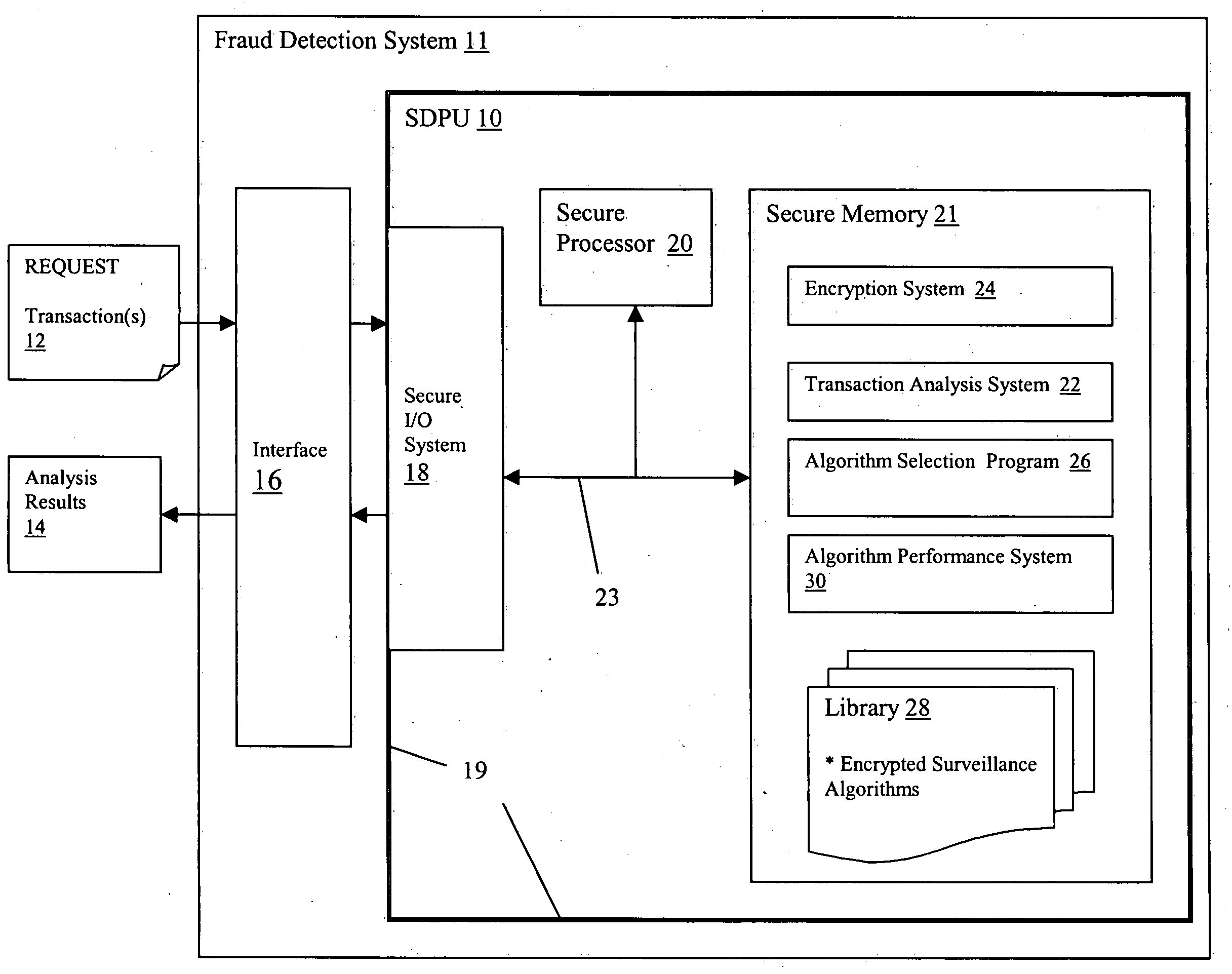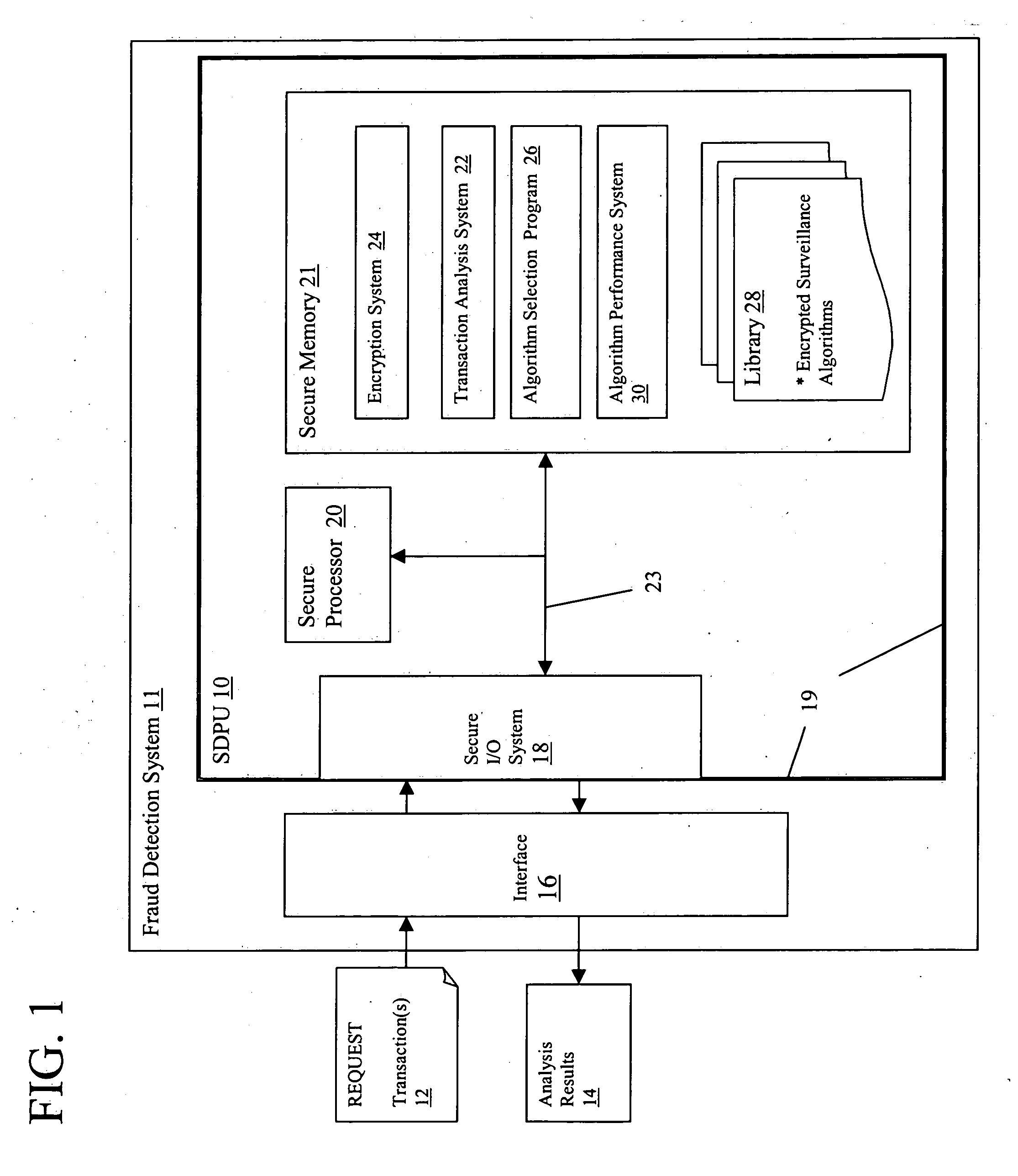Confidential fraud detection system and method
a fraud detection and confidential technology, applied in the field of computer security, can solve problems such as lack of control of third parties, creating challenges for financial institutions, and sharing data between distinct institutions or between lines of business (lobs) within an institution, and achieve the effect of facilitating fraud detection
- Summary
- Abstract
- Description
- Claims
- Application Information
AI Technical Summary
Benefits of technology
Problems solved by technology
Method used
Image
Examples
1 embodiment
Type 1 Embodiment
[0039] The first embodiment (Type 1), shown in FIG. 1, addresses the need for providing secrecy to the algorithms and methods being used to identify fraud. If an adversary knows how a surveillance system tracks potentially fraudulent events (e.g., it looks for transactions greater than $1 million), then the adversary can take steps to avoid such behaviors. Thus, secrecy of at least some of the methods and / or algorithms to be used by the transaction analysis system 22 provides a decisive advantage.
[0040] To achieve such a solution, SDPU 10 provides a library 28 of encrypted surveillance algorithms that are interchangeably utilized by transaction analysis system 22. It is understood that each “surveillance algorithm” may be implemented in any manner, e.g., as piece of a computer program, as an entire computer program, as a dynamically linked library, etc. Accordingly, the term surveillance algorithm may also be referred to simply as a “surveillance program” within th...
2 embodiment
Type 2 Embodiment
[0052] The second embodiment, described with reference to FIG. 2, addresses the fact that in order to implement an effective fraud detection system, large data sets are required. To achieve larger data sets, the second embodiment provides a confederated fraud detection system 40 utilizing a type 2 SDPU 42. SDPU 42 includes the same fundamental architecture as the type 1 SDPU 10 described above with respect to FIG. 1. In particular, SDPU 42 includes a security system with secure I / O 46, secure processor 44, secure memory 48, a secure communication channel 68, a transaction analysis system 50, an encryption system, etc.
[0053] The type 2 SDPU 42 however includes additional functionality that allows data from a plurality of firms 54 to be consolidated at a consolidated database 52 within the secure memory 48. In particular, SDPU 42 includes a data consolidation system 62 that imports encrypted data 56 from each of the participating firms 54, and then stores the data in...
example 1
Check Fraud Prevention
[0057] Check fraud has many facets, some of which are harmful mostly to the party accepting the fraudulent check. The banks can be harmed by not recognizing bad checks after they have been deposited, and fraud detection will become even more important with the push toward check truncation, where check images will be kept, but the original destroyed by the banks. Typical examples of frauds that are bad not only to the accepting party but also to the banks are: multiple deposit, change of payee's name, change of amount, use of stolen blank check, use of counterfeited blank checks. Accessing a larger set of data about checks from the same payer obviously increases the chances of detecting a fraud. For instance, this may help detect: [0058] (1) multiple deposits of several unaltered copies of the same check, [0059] (2) multiple deposits of several altered copies of the same check, (*) [0060] (3) frauds by change of the payee's name (*) [0061] (4) frauds by change ...
PUM
 Login to View More
Login to View More Abstract
Description
Claims
Application Information
 Login to View More
Login to View More - R&D
- Intellectual Property
- Life Sciences
- Materials
- Tech Scout
- Unparalleled Data Quality
- Higher Quality Content
- 60% Fewer Hallucinations
Browse by: Latest US Patents, China's latest patents, Technical Efficacy Thesaurus, Application Domain, Technology Topic, Popular Technical Reports.
© 2025 PatSnap. All rights reserved.Legal|Privacy policy|Modern Slavery Act Transparency Statement|Sitemap|About US| Contact US: help@patsnap.com



